-
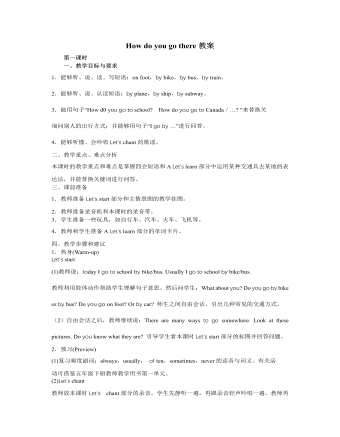
人教版新课标PEP小学英语六年级上册How do you go there教案
教师检查有多少学生能够准确区分14与40的发音,如果答对率低,教师要注意纠正。教师还可以板书一组相似的数字,如:13/30,18/80,15/50,教师说英文,学生说出中文的数字,帮助学生区分/-ti:n/与l-u/。 3.新课呈现(Presentation) Let’s talk (1)教师根据学生平时常去的场所提问,如当地的一家电影院、风景点、或学生的祖父母家等:“How can you get to…? Can you go by …? Is it fast/slow/expensive to go by …? ”进行师生间的自由会话,再让学生感知一下新句型:How can I/ you get to…? 然后,教师请学生根据课本中提供的地图回答问题:“How can I get to Zhongshan Park? ”引导学生回答,提示他们坐15路公交车为:“By the No.15 bus.”教师提供完整的答句:“Yes.I can go by the No.15 bus.”教师板书这组句子。 (2)教师继续提问:“It’s a place.You can buy food,drink,fruit,veget ables,school things and clothes there.What is it? (It’s a supermarket.)”教师最好出示一张当地比较有名的超市的照片或图片来给出谜底。教师再提问:“How can I get there? By bus or by bike? ”然后领读句子:“I can go to the supermarket by …”帮助学生理解supermarket是一个合成词,来源于super与market。
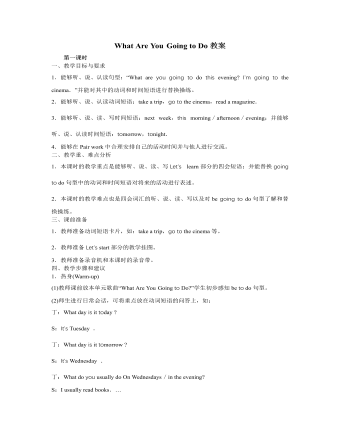
人教版新课标PEP小学英语六年级上册What Are You Going to Do教案
1.热身(Warm-up) (1)全班一起吟唱Let’s chant的歌谣。 (2)单词拼写竞赛 要拼写的单词包括:this morning/afternoon/evening,next week,newspaper, postcard等。可采取小组合作的“接龙式”拼写形式;也可以选取组内一名学生拼写全部单词。拼出单词最快最多的组获胜。 (3)教师出示简明地图,师生问答如下: r:What shop is it? s:It’s a bookstore. r:What can you buy in the bookstore? s:… 在学生回答各商店所出售的物品时,教师根据其回答贴出物品的小卡片,如: Fruit stand:orange,apple,pear,banana….Shoe store:sneakers,sandals,boots….(此时可引导学生说“a pair of sneakers/boots’’等) 2.预习(Preview) Let’s try 教师指着地图中的商店及各商店所出售的物品说:Look!There are so many stores and so many goods.Let’s listen to the tape and find out:①Where is Sarah going? ②What is she going to buy? ③Who is she going with? 教师放三遍Let’s try部分的录音,以上问题可根据学生的实际情况分三次提出,直到多数学生能回答并能将前两项答案填人教师课前画出的表格中。在填表过程中,教师请学生一起拼写其中的四会单词,如:bookstore,comic book。
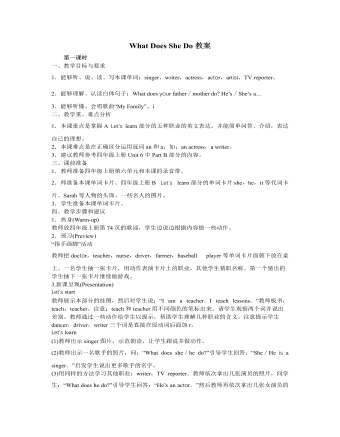
人教版新课标PEP小学英语六年级上册What Does She Do教案
(3)教师就黑板上的内容和学生做对话练习,如:What does your mother do?Where does she work?How does she go to work?教师板书“Where does she work?”和“How does she go to work?”,示范朗读,学生跟说。学生两人一组根据黑板上的语言提示做对话练习。 (4)“看卡片,说句子”活动 教师面前放一摞单词卡片,依次为:职业名称卡片,工作地点卡片和交通方式卡片。活动开始,教师随意从第一摞卡片中抽取一张职业卡片,如:engineer,举起来问:“What does your father do?”学生回答“He’s an engineer.”教师继续抽取一张工作地点卡片,举起来,如:Car company,问:“Where does he work?”学生说:“He works in a Car company.”教师再抽取一张交通方式卡片,如:bus,问:“How does he go to work?学生回答:“He go es to work by bus.”游戏进行几轮后,可以请几名学生轮流代替教师抽卡片,提问题。 (5)教师放本部分的录音,学生跟读。学生两人一组读课文对话。 (6)学生两人一组做对话替换练习。 (7)教师指导学生书写四会句子。 4.巩固和延伸(Consolidation and ex tension) Group work
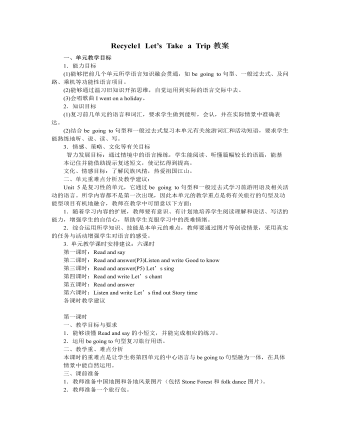
人教版新课标PEP小学英语六年级下册Recycle1 Let’s Take a Trip教案
4.巩固和扩展(Consolidation and extension) (1) 做本单元活动手册配套练习。 (2) 翻卡片说单词。学生两人一组,把单词卡片反面朝上放在桌子上,然后同时翻开两张单词卡(如:going, holiday),就马上组织成一句话(如:Where are you going on the holiday?/ I’m going to Kunming this holiday.),说得快又正确者为胜。 (3) 教师播放C部分Story time的录音或VCD,帮助学生理解故事内容。学生再听一遍录音,跟读故事里的句子,教师指导学生发音。 (4) Bright eyes. 在黑板上张贴Let’s find out的8幅图片,Mike, Zhang Peng, Sarah, Kathy等4个人物图片分别放在8幅图片上,如:Mike ---take pictures---buy presents。学生仔细观察后,请学生闭上眼睛,教师就趁学生闭眼之际交换人物位置(如把Mike放到eat noodles),然后请学生张开眼睛回答:What did Mike do just now ? 引导学生回答: Mike took pictures and bought presents. 教学参考资料库 1.文化背景介绍: 机场标志: Airport 飞机场 Airport lounges 机场休息室Airports shuttle 机场班车 Arrivals 进港Assistance 问讯处Check in area (zone) 办理登机区Departure airport 离港时间Departure times on reverse 返航时间 Welcome aboard 欢迎登机
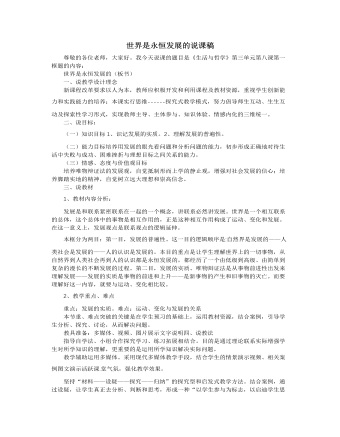
人教版高中政治必修4世界是永恒发展的说课稿(一)
5.课堂练习,夯实基础。得出原理方法论之后,给学生一分钟时间记忆,然后一名或几名学生上讲台默写,其他同学相互提问。针对这一基本概念,设置一道选择题。6、播放黄宏、宋丹丹小品《回家》片段,引发学生的兴趣,接着教师展示几幅关于手机的图片,然后让学生结合图片,进行讨论交流解决“合作探究二”,然后进行抢答(可以引发学生的竞争,从而调动课堂气氛)。教师在学生回答基础上,引导学生得出发展的实质这一结论,接着教师展示“如何判断一个事物是新事物还是旧事物的标准”,结合这一标准,让学生判断“电脑科技算命是不是新事物”,学生很容易就可以得出结论。7.教师简单总结刚刚学过的内容,引出“运动、变化是不是发展?”然后让学生讨论交流“合作探究三”。然后进行抢答,教师在学生回答基础上,稍加点评,给予积极地评价,然后展示答案。8.教师引导学生得出本节课的第二个原理与方法论,并让学生当堂记忆,可以简单提问。然后做课堂达标题,在学生展示答案后,教师简单点拨即可。
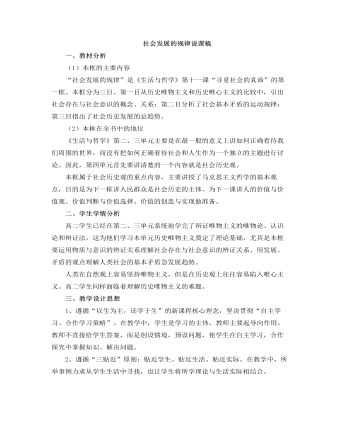
人教版高中政治必修4社会发展的规律说课稿(二)
“最佳实践者”活动凸显了“尊重劳动”的理念。运用历史唯物主义有关原理。说明为什么药“尊重劳动”。(10分)参考答案:①生产方式是社会存在和发展的基础,生产力是社会发展的最终决定力量,尊重劳动是尊重社会发展规律的必然要求;(3分)③人民群众是历史的创造者,尊重劳动是尊重人民群众社会实践主体地位的要求;(2分)④尊重劳动是以人民群众利益为最高价值标准的必然要求;(2分)⑤劳动者的价值通过劳动实现,尊重劳动是尊重实践、提高劳动者积极性和创造性的必然要求。(3分)七、教学反思本节课教学目标明确,教学重点、难点设置恰当,教学过程详略得当,教学过程流畅。教师充分利用时政热点和生活故事,创设情景,使学生融入教学活动过程之中,充分发挥了学生的主体作用,在体验中提高了认识能力和知识水平,促进了学生的理解能力、思维能力和解决问题的能力,促进了学生的发展。
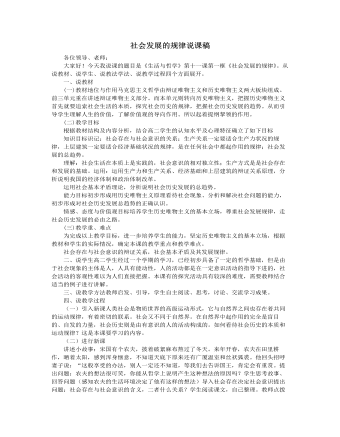
人教版高中政治必修4社会发展的规律说课稿(一)
学生回答:推动社会发展的矛盾是:生产力和生产关系的矛盾,经济基础和上层建筑的矛盾。问题:你知道人类社会存在和发展的基础吗?学生回答,步步深入。社会发展的规律是生产关系一定要适合生产力发展的规律,上层建筑一定要适合经济基础状况的规律。你是如何理解这两个规律的?请举例说明。那么你是如何理解这一规律的,请举例说明学生阅读教材第二目,并举例说明。培养学生自我学习能力。教师归纳:总结生产力和生产关系、经济基础和上层建筑的辩证关系原理。过渡:我们掌握了社会发展的规律,那么同学们来说一下,社会发展呈什么趋势?这一趋势怎么实现的?社会矛盾的解决方式有几种,为什么会有这么的区别,我们国家的矛盾解决靠什么方式来完成?学生阅读教材第三目,学生分组合作探究,交流发言。设计意图:提升推导能力,引导深化认识。教师归纳总结:社会历史发展的总趋势是前进的、上升的,发展的过程是曲折的。
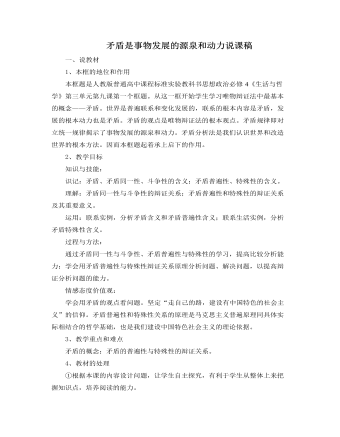
人教版高中政治必修4矛盾是事物发展的源泉和动力说课稿(二)
一、说教材1、本框的地位和作用本框题是人教版普通高中课程标准实验教科书思想政治必修4《生活与哲学》第三单元第九课第一个框题。从这一框开始学生学习唯物辩证法中最基本的概念——矛盾。世界是普遍联系和变化发展的,联系的根本内容是矛盾,发展的根本动力也是矛盾。矛盾的观点是唯物辩证法的根本观点。矛盾规律即对立统一规律揭示了事物发展的源泉和动力。矛盾分析法是我们认识世界和改造世界的根本方法。因而本框题起着承上启下的作用。2、教学目标知识与技能:识记:矛盾、矛盾同一性、斗争性的含义;矛盾普遍性、特殊性的含义。理解:矛盾同一性与斗争性的辩证关系;矛盾普遍性和特殊性的辩证关系及其重要意义。运用:联系实例,分析矛盾含义和矛盾普遍性含义;联系生活实例,分析矛盾特殊性含义。
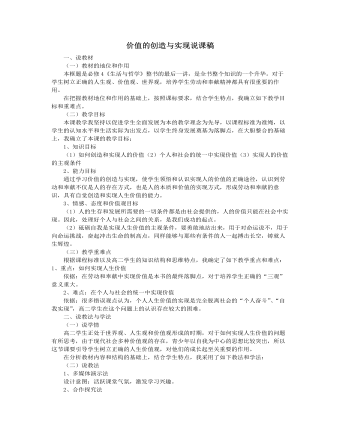
人教版高中政治必修4价值的创造与实现说课稿(一)
(六)巩固练习:习题见教学设计(七)布置作业:适量的同步练习题设计意图:反馈矫正,以便于进行教后反思。四、说教学反思新课程理念呼唤改变学生的学习方式,建立旨在调动和发挥学生主体作用的自主、合作、探究的学习方式。鼓励学生结合实际大胆对一些问题进行探究,在活动中体验和领悟,从而构建新的知识。通过探究、思辨、实践等方式,引导学生生成核心哲学观点,展示学生生活智慧,培养科学思维习惯,提升学生思维能力,形成情感、态度与价值观。本课例在设计时围绕本框的三个知识点:“在劳动和奉献中创造价值”、“在个人与社会的统一中实现价值”和“在砥砺自我中走向成功”,按照“情境导入——激发情意——自主学习,合作探究。”模式展开教学。在这样的教学中,我们收获了新课改教学经验,但是也存在着不足,日后还需继续加以改进。
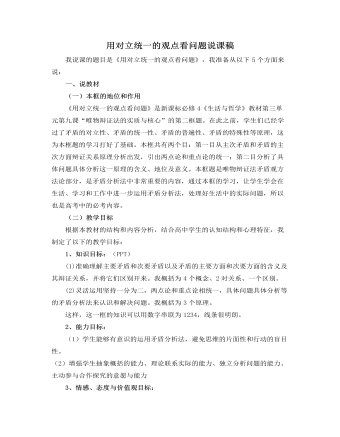
人教版高中政治必修4用对立统一的观点看问题说课稿(二)
【设计意图】通过认识自我这一环节的设计,让学生能够准确的理解矛盾的主次方面,做到能够正确的评价事物,尤其是能够正确的认识评价自己和他人,做到扬长避短,从而达到情感态度价值观目标。为了更好的区分主次矛盾与矛盾的主次方面,在此我以小组赛的形式设计了【我用我学正确识别】这一学生合作探究活动来强化对知识的掌握。(用时大约6分钟)。通过对难点主次矛盾和矛盾主次方面的深入学习,师生共同找出其共同之处:均是两点与重点,从而讲解主次矛盾和矛盾主次方面共同的方法论要求:坚持两点论与重点论的统一。3、坚持具体问题具体分析(约8分钟)由于第二目知识点具体问题具体分析内容上比较简单,因此在过渡后主要以学生自学为主,我围绕“成功”制作两个幻灯片作简单讲解与归纳。
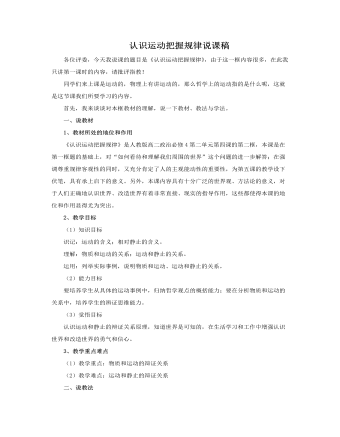
人教版高中政治必修4认识运动把握规律说课稿(二)
归纳:第一句正确。承认运动的绝对性。第二句错误。否认相对静止的存在。3.课堂小结,强化认识(2—3分钟)课堂小结,可以把课堂传授的知识尽快地转化为学生的素质;简单扼要的课堂小结,可使学生更深刻地理解政治理论在实际生活中的应用,并且逐渐地培养学生具有良好的个性。人类社会是物质世界长期发展的产物,世界的本质是物质,世界的真正统一性就在于它的物质性,物质又是运动的,运动的形式多种多样,运动又是物质的运动,物质和运动是不可分割的,运动和静止既有区别又有联系,物质的运动是绝对的、无条件的和永恒的,而静止是相对的、有条件的和暂时的。4.板书设计我比较注重直观,系统的板书设计,还及时地体现教材中的知识点,以便于学生能够理解掌握。

人教版高中政治必修4时代的精神的精华说课稿
(二)能力目标培养学生运用哲学理论观察、分析、处理社会问题的能力,增强学生的时代感。(三)情感、态度与价值观目标培养学生与时俱进的思想品质,让学生关注时代、关注现实、关注生活,逐步树立科学的世界观、人生观、价值观。三、说教学重难点:时代精神的总结和升华是本框的难点,虽然学生在文化生活中学习了文化与经济政治的关系,但要让学生得出哲学是时代精神的总结和升华,还要联系前面关于哲学的基础知识进行总结归纳,因此可能会难以把握,另外关于什么样的哲学是真正的哲学的理解会稍有难度。社会变革的先导是本框的重点,一方面哲学源于时代,另一方面强调哲学反过来对时代又有重要的反作用,突出这一点能够更好地激发学生学习哲学的热情和信心,对于后面知识的学习是极为有益的,因此社会变革的先导这一目作重点处理。
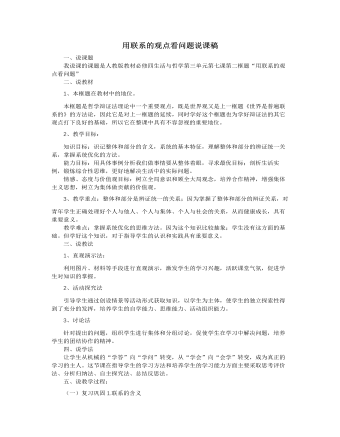
人教版高中政治必修4用联系的观点看问题说课稿
2、系统的基本特征系统观念为人们把握复杂事物提供了一系列科学方法和原则。第一,整体性原则。第二,有序性原则。第三,优化原则。学生的兴趣被激发,可以再调起高潮,让学生听一首歌曲,三个和尚挑水,让学生从愉快的歌声中,明白一个道理:“三个和尚没水喝”,导致这一结果的根本原因就在于人数虽然多了,但没有形成合理的结构,不是相互支持,相互促进,而是相互制肘、相互消磨,结果各要素的力量或作用被内耗了,出现了1+1<2的效应。所以,就要求我们一定要做到:3、掌握系统优化的方法的要求(1)着眼于事物的整体性;遵循系统内部结构的有序性;注重系统内部结构的优化趋向。(2)用综合的思维方式来认识事物巩固练习:以巩固知识为基础,培养能力为目标。
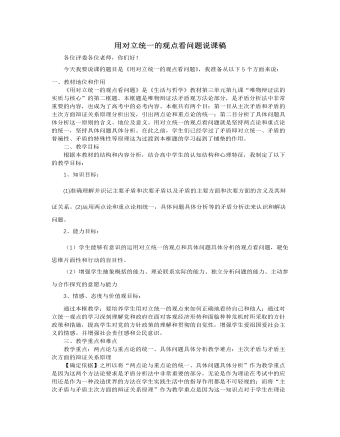
人教版高中政治必修4用对立统一的观点看问题说课稿(一)
1、课题引入:11月16日9时40分许,甘肃庆阳市正宁县榆林子镇发生一起重大交通事故,“校车安全”又一次甚嚣尘上,我设计提问“校车安全事故然表面是偶然,但又是一种必然,你认为事件的原因何在?”的问题激发学生的阅读兴趣。我设计典型事例,通过学生讨论,教师总结的形式,并得出主次矛盾辩证关系的原理分析。2、具体分析事件背后的原因,从原因中发现,这众多的原因矛盾中,都有主次方面之分,由于得出矛盾的主次方面原理。3、从原因中,寻找对策,既坚持重点论与两点论的结合。反对一点论和均衡论。4、无独有偶,在2011年在湖南,海南,广西等地均有类似的事件发生。对比各地事故背后的原因,得出应具体问题具体分析。进而分析具体问题具体分析的意义及地位。
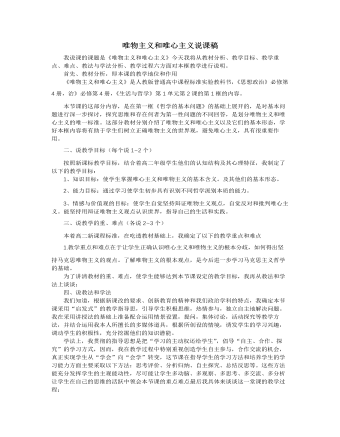
人教版高中政治必修4唯物主义和唯心主义说课稿
五、说教学过程(重点说)1、课题引入:我设计以提问哲学到底是什么?的问题激发学生的阅读兴趣。我设计典型事例,通过学生讨论,教师总结的形式,并得出其实哲学就在我们身边。2、讲授新课:(35分钟)通过教材第一目的讲解,让学生明白,生活和学习中有许多蕴涵哲学道理的故事,表明哲学并不神秘总结并过渡:生活也离不开哲学,哲学可以是我正确看待自然、人生、和社会的发展,从而指导人们正确的认识和改造世界。整个过程将伴随着多媒体影像资料和生生对话讨论以提高学生的积极性。3、课堂反馈,知识迁移。最后对本科课进行小结,巩固重点难点,将本课的哲学知识迁移到与生活相关的例子,实现对知识的升华以及学生的再次创新;可使学生更深刻地理解重点和难点,为下一框学习做好准备。
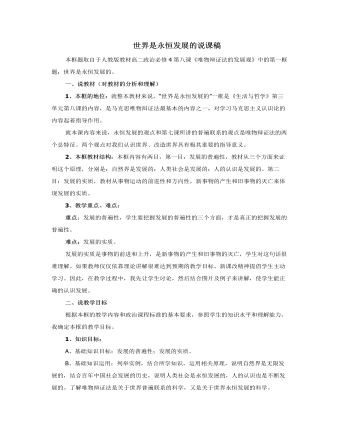
人教版高中政治必修4世界是永恒发展的说课稿(二)
四、说学法哲学知识是比较抽象的,大多数学生都觉得哲学的内容很难把握,因此,针对学生的实际情况,在教学中必须发挥学生学习的主动性。通过观察、教师的引导及讨论来加深理解;通过练习来巩固所学知识。1.观察法:引导学生观察生活中的现象,加深理解发展的普遍性和发展的实质。2.探究法:让学生在讨论中体会发展的永恒性,知道用发展的观点看问题。3.练习法:“温故而知新”,学以致用,及时给一些习题让学生练习,让他们更能把握教材内容。五、说教学过程:[导入新课]引用一个历史故事来导入新课。(利用多媒体课件展示)[讲授新课]第一目:发展的普遍性①、自然界是发展的。(展示人的进化过程的图片和青蛙成长过程的图片,结合教材的例子来说明自然界是发展的)
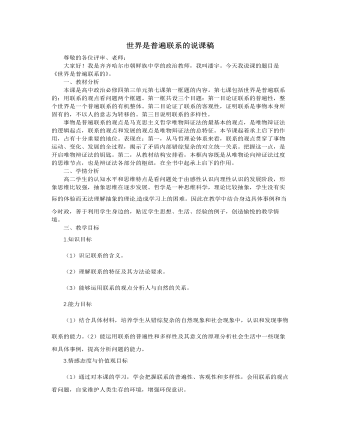
人教版高中政治必修4世界是普遍联系的说课稿
新课程要求学生知识的获得由静态预设到动态生成。作为唯物辩证法的一个总特征、用联系的观点看问题是学生遇到的第一个辩证法思想。本教学设计由日常生活中我们所熟知的情境入手引申到联系的概念、使学生领悟到成语中蕴藏着丰富的哲理。而后通过分析日常生活中的事例一一讲解联系的普遍性、客观性和多样性、体现出生活处处有哲学的理念,符合学生的认知规律。在教学过程中、本教学设计安排了必要的学生活动、锻炼了学生的思维、充分发挥了学生的主体作用。在这一过程中,知识、情感、态度、价值观目标也得到了实现。具体分析如下:第一、这节课利用多媒体教学方式,把书本与丰富多彩的社会生活联系在一起。扩大了学生的眼界和见闻,打破了课堂学习时空的局限,打开了学生思维的心扉,使学生不断产生浓厚的兴趣和探究社会真谛的热情,并真正成为学习的主人,使学生真正成为教学过程的主体。
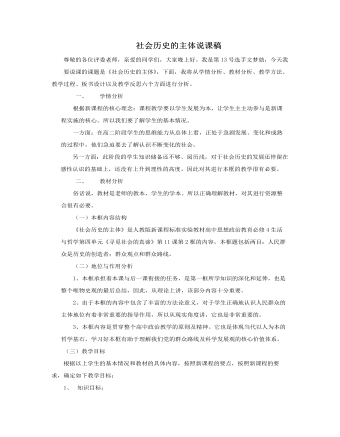
人教版高中政治必修4社会历史的主体说课稿(二)
一、 学情分析根据新课程的核心理念:课程教学要以学生发展为本,让学生主主动参与是新课程实施的核心。所以我们要了解学生的基本情况。一方面:在高二阶段学生的思维能力从总体上看,正处于急剧发展、变化和成熟的过程中,他们急迫要去了解认识不断变化的社会。另一方面:此阶段的学生知识储备还不够、阅历浅,对于社会历史的发展还停留在感性认识的基础上,还没有上升到理性的高度。因此对其进行本框的教学很有必要。二、 教材分析俗话说,教材是老师的教本,学生的学本。所以正确理解教材,对其进行资源整合很有必要。(一)本框内容结构《社会历史的主体》是人教版新课程标准实验教材高中思想政治教育必修4生活与哲学第四单元《寻觅社会的真谛》第11课第2框的内容,本框题包括两目:人民群众是历史的创造者;群众观点和群众路线。
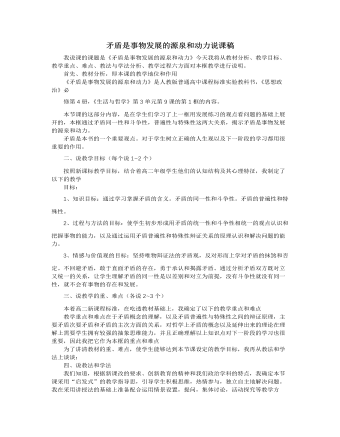
人教版高中政治必修4矛盾是事物发展的源泉和动力说课稿(一)
《矛盾是事物发展的源泉和动力》是人教版普通高中课程标准实验教科书,《思想政治》必修第4册,《生活与哲学》第3单元第9课的第1框的内容。本节课的这部分内容,是在学生们学习了上一框用发展练习的观点看问题的基础上展开的,本框通过矛盾同一性和斗争性,普遍性与特殊性这两大关系,揭示矛盾是事物发展的源泉和动力。矛盾是本书的一个重要观点。对于学生树立正确的人生观以及下一阶段的学习都用很重要的作用。二、说教学目标(每个说1~2个)按照新课标教学目标,结合着高二年级学生他们的认知结构及其心理特征,我制定了以下的教学目标:1、知识目标:通过学习掌握矛盾的含义。矛盾的同一性和斗争性。矛盾的普遍性和特殊性。2、过程与方法的目标:使学生初步形成用矛盾的统一性和斗争性相统一的观点认识和把握事物的能力,以及通过运用矛盾普遍性和特殊性辩证关系的原理认识和解决问题的能力。
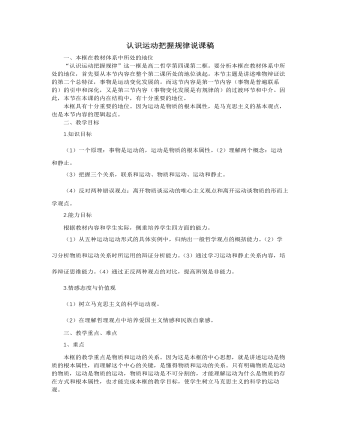
人教版高中政治必修4认识运动把握规律说课稿(一)
(7)精讲即精讲点拨,释疑解难。现代教育理论一方面强调学生学习的主动性;另一方面也重视发挥教师的积极性。课堂活动的主动性、合理性、有效性的实现还有赖于教师的讲。精讲就要求教师的讲授内容精要,分析精辟,语言精彩、节奏精练、点拨精当。从内容上看,本节课精讲主要有三处:一、运动的含义;二、运动是物质的根本属性;三、静止是运动的特殊状态。2、教学手段多媒体辅助教学。六、教学过程第一步:创设情景,用“谜语”导入新课。使学生置身于教学内容的情景之中,产生继续探究的强烈愿望。第二步:运用直观、形象的画面将教学目标问题,唤起学生参与欲望,驱使学生去思考,去自读。第三步:引导学生相互讨论,实现学生之间的横向交流。第四步:教师依据反馈信息,给予重点讲授、提示点拨、搭桥铺路。第五步:设置故事型的模拟法庭,开展讨论,在高潮中结束新课。第六步:总结概括,深化知识,形成网络。

